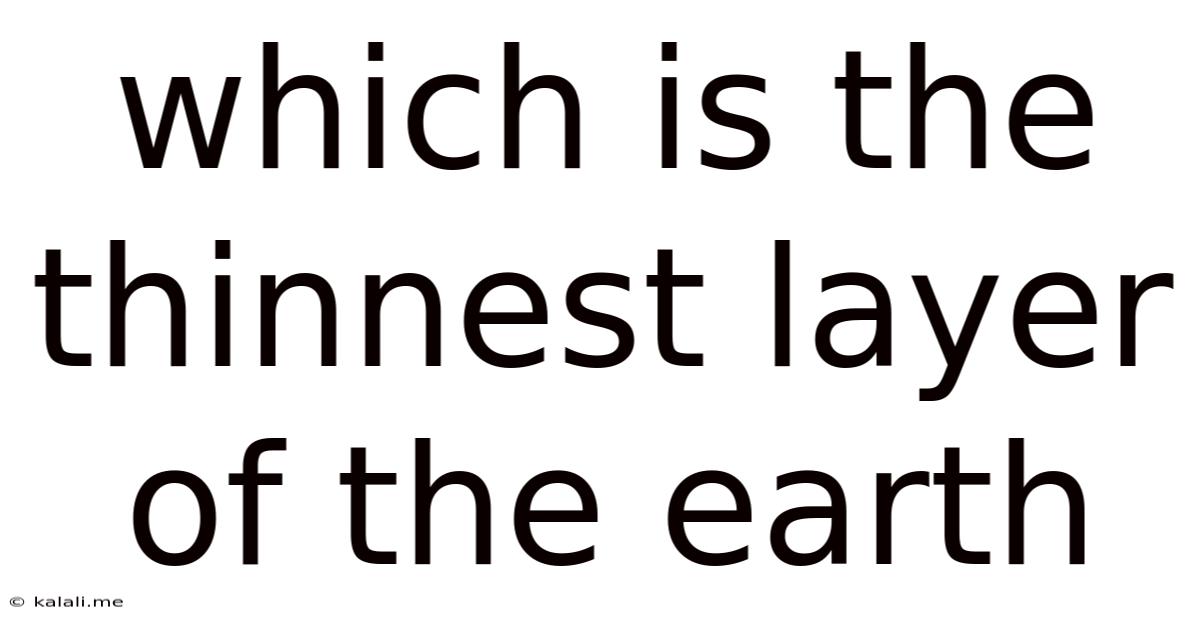Which Is The Thinnest Layer Of The Earth
Kalali
Jun 11, 2025 · 3 min read

Table of Contents
Which is the Earth's Thinnest Layer? Understanding the Earth's Structure
The Earth is a complex system, comprised of several distinct layers, each with its own unique characteristics. Understanding these layers is crucial for comprehending geological processes, from earthquakes to volcanic eruptions. But which layer is the thinnest? The answer is surprisingly straightforward: the Earth's crust is the thinnest layer. This article will delve deeper into the Earth's structure, explaining why the crust takes the crown for thinnest layer, and exploring its different types and significance.
The Earth's structure is typically divided into four main layers: the crust, the mantle, the outer core, and the inner core. While the inner core is incredibly hot and dense, and the mantle makes up the bulk of the Earth's volume, it's the crust that holds the title of thinnest. Think of it like an eggshell – thin yet crucial for the integrity of the entire structure.
The Earth's Crust: A Fragile Outer Shell
The crust is the outermost solid shell of our planet, and it's remarkably thin compared to the other layers. Its thickness varies significantly depending on location. Oceanic crust, found under the oceans, is considerably thinner than continental crust, which forms the continents.
-
Oceanic Crust: This type of crust is typically only about 5 to 10 kilometers (3 to 6 miles) thick. It's primarily composed of basalt, a dark-colored volcanic rock, and is denser than continental crust.
-
Continental Crust: This is much thicker, ranging from 30 to 70 kilometers (19 to 43 miles) in thickness. It's composed of a variety of igneous, metamorphic, and sedimentary rocks, and is less dense than oceanic crust. The thicker continental crust is responsible for the higher elevation of continents compared to ocean basins. Mountain ranges, such as the Himalayas, represent exceptionally thick portions of continental crust.
Comparing the Crust to Other Layers
To further illustrate the crust's thinness, let's consider the other layers:
-
Mantle: The mantle is the thickest layer, extending to a depth of approximately 2,900 kilometers (1,802 miles). It's primarily composed of silicate rocks and is much denser than the crust.
-
Outer Core: This liquid layer is about 2,200 kilometers (1,367 miles) thick and is composed mostly of iron and nickel.
-
Inner Core: The innermost layer, the inner core is a solid sphere with a radius of about 1,220 kilometers (758 miles), primarily composed of iron and nickel. Despite its extreme pressure and temperature, it's still the least voluminous layer.
The stark contrast in thickness between the crust and the other layers highlights the crust's relative fragility. It is the layer we directly interact with, and its structure and composition influence the landscape, resources, and geological events we experience on Earth's surface.
The Significance of the Earth's Thinnest Layer
Despite its thinness, the crust plays a vital role in shaping our planet. It's where we find most of Earth’s resources, from minerals to fossil fuels. Plate tectonics, the movement of the Earth's crustal plates, is responsible for earthquakes, volcanoes, and the formation of mountains and ocean basins. Studying the crust is fundamental to understanding these dynamic processes and predicting potential geological hazards. The thinness of the crust is a factor in the intensity and frequency of these events.
In conclusion, while the Earth's inner layers are far more massive, it's the crust that holds the title of thinnest layer. Understanding its composition, structure, and dynamic interactions with the other layers is essential for comprehending our planet's past, present, and future.
Latest Posts
Latest Posts
-
How Many Oz In A Lb Of Pasta
Jul 01, 2025
-
What Year Was I Born In If Im 19
Jul 01, 2025
-
How Many Cups Is 238 Grams Of Miralax Powder
Jul 01, 2025
-
How Much Is Half A Billion Dollars
Jul 01, 2025
-
How Many Days Are In 9 Years
Jul 01, 2025
Related Post
Thank you for visiting our website which covers about Which Is The Thinnest Layer Of The Earth . We hope the information provided has been useful to you. Feel free to contact us if you have any questions or need further assistance. See you next time and don't miss to bookmark.